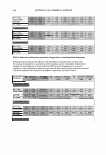ADHESION FAILURE IN HAIR 365 across the fiber, stress concentrations can be relieved or diverted along the fiber axis through the intercellular cement or through flaws such as the medulla, until the stress is relieved by fiber breakage. Step fractures can also occur by simultaneous propagation of two cracks on opposite sides of the fiber, perpendicular to the fiber axis and then shearing along cortical cell surfaces through the CMC along the axis until the fiber snaps. At low RH, failure generally occurs in the CMC rather than inside cortical cells (12). At 65% RH, cortical cells may be torn apart, although this action does not appear to occur frequently. SUNLIGHT DAMAGE Extending hair fibers to break that have been previously damaged from disulfide bond rupture or thioester bond breakage (Figure 2) by ultraviolet light or sunlight and the consequent changes leads to multiple step fractures (see Figure 15) (Ruetsch, private communication). The entire fiber is weakened by these chemical changes, including the cortex-cortex cell membrane complex, where both axial and lateral propagation of frac tures can occur more extensively than before this type of damage. This type of CMC weakening provides multiple step fractures (see Figure 15). Additional damage from extended sunlight exposure breaks peptide bonds and forms new crosslinks, leading to a very brittle fiber that provides rapidly formed smooth fractures in the periphery or the most damaged region of the fiber. Figure 15 shows smooth fracturing in the periphery (the most chemically modified part of the fiber) and multiple step fractures in the interior of the fiber. Figure 15. UV-brittle damage and "cathedral" fracture leaving smooth fracture near surface layers and multiple step fractures inside the fiber (21). Reprinted with permission of the Journal of Cosmetic Science.
366 JOURNAL OF COSMETIC SCIENCE In the final stages of sunlight damage to hair, the cuticle layers are very brittle from the chemical changes brought about by degradation of the disulfide crosslinks and the creation of crosslinks from peptide bond alterations. Because of the extensive transfor mations in the fiber, much cuticle differentiation disappears. Thus, in addition to failure in the fiber interior, when deformed, the fibers provide cracks in the outer brittle cuticle that are perpendicular to the fiber axis (see Figure 16). FRACTURING OF BLEACHED AND PERMED HAIR Hair bleaches provide damage to disulfide bonds and some damage to thioester and even to ester linkages (see the monolayer model of Figure 2B and the bilayer model of Figure 3) Bleached hair is especially sensitive to the subsequent reductive action of thioglycolate perms, leading to fibers that behave very similarly under extension to sunlight-damaged hair by providing multiple step fractures in the cortex (see Figure 17). This effect occurs because of the highly weakened cortex-cortex CMC, which provides for a much larger number of routes for the axial diversion of fractures than before these chemical changes to the fiber. BENDING AND FAILURE OF ADHESION Failure of adhesion caused by bending and torsional deformations needs to be examined more fully where deformation conditions, relative humidity, and hair condition are Figure 16. Sun damage leaving surface cracks perpendicular to the fiber axis upon stretching (S. Ruetsch, private communication). SEM by S. Ruetsch, TRI Princeton.
Purchased for the exclusive use of nofirst nolast (unknown) From: SCC Media Library & Resource Center (library.scconline.org)






































































































